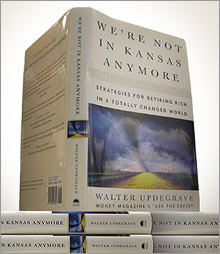|
|
|
|
|
|

|
|
More information on Updegrave's new book.
|
|
|
|
|
NEW YORK (CNN/Money) -
No matter what I do, I blow whatever money I have each month. I just can't seem to save. How can I teach myself to put something away for long-term goals rather than spending everything right now?
-- Judy Ramsey, Little Rock, Arkansas
I'm sure that before scientists finish sifting through the various fibers in our DNA, they'll eventually discover the "spend everything I have and more" gene.
Not that I want to make excuses for spendthrift habits. But it seems to me that the propensity of humans -- and Americans in particular -- to spend is so great that it's got to be ingrained in our very being. (Yes, I know the Japanese are quite frugal, but they're a case of the exception proving the rule.)
Anyway, regardless of whether our free-spending ways are the result of nature, nurture or a lack of discipline, it's important to overcome them and find a way to put money away on a regular basis. Because if you don't do that, your chances of achieving any sort of financial security, particularly in retirement, are virtually nil.
So, what to do?
Some people think the answer to this question lies in setting a good budget and sticking to it. By doing this, advocates of the budget approach say, you can see where every cent of your income is going, and you can pare back areas where you're spending too much and come away with some savings. For more on this approach, click here.
But the problem I see with the budget approach is that too often, despite our best intentions, we never get around to saving a portion of our dough.
We cash our paycheck or see those funds deposited into our bank and our neat little budgetary system begins to crumble. We have car payments due, a mortgage payment, then maybe an unexpected school bill or medical expenses. We discover we need some new clothes or the car breaks down...and before you know it, there's nothing left.
Or even if there is a bit left over, we think, ah, what's the point. I might was well use the pittance that's left for a nice dinner and resolve to begin my savings program next month.
Create a system
The way around this problem is to create a system where you are saving your money before you get your hands on it. Just have a portion of your income go directly into some type of savings or investment vehicle automatically each month so that you don't have to make a conscious decision to save.
By doing this, you engage in a little helpful mental trickery. Instead of thinking of your entire income as the amount of money you have to live on, you begin to think of your after-savings income as what you have to get by on each month. Thus, you gain the psychic rewards of thinking you're spending everything you make, while in reality you're living below your means.
And that, after all, is what saving is all about. Living a bit below your means today so that you'll be able to weather financial setbacks and, ultimately, live comfortably in retirement when you don't have that steady paycheck coming in.
The best way to pull of this little illusion is to sign up for your company's 401(k) plan. Not only will your 401(k) contributions be deducted from your pay before you have a chance to get your greedy little lunch hooks on them, you'll also get two nifty tax breaks: your contribution isn't taxed until you withdraw it and the investment gains your contribution generates also go untaxed until you pull them out of the account (preferably after you retire).
Automating investments
If your employer doesn't offer a 401(k), there's another way to save without you having to sit down and actually write a check: sign up for an automatic investment plan.
Most fund companies offers such programs, which typically involve you agreeing to have the fund company automatically transfer a specific amount (usually $50 or more) from your checking account into the fund. You can set up one plan with an IRA account to take advantage of the tax benefits IRAs offer. And if you can manage to save more, you can set up a separate non-IRA plan as well.
Caveat: Do not open up what's known as a "contractual investing plan." Although such plans involve the same principal as automatic investment plans, a recent NASD Investor Alert warns that contractual plans often involve high fees that can seriously dilute the benefits of regular saving.
So start contributing to your 401(k) or set up an automatic plan -- or, for that matter, why not do both? In the beginning you might notice the shrinkage in your paycheck. But after a while you'll adjust to this new reality and you won't notice it at all. One thing you will notice, however, is that you'll have a stash of savings that over time can grow into a sum you probably never imagined you could accumulate.
Walter Updegrave is a senior editor at MONEY Magazine and is the author of "We're Not in Kansas Anymore: Strategies for Retiring Rich in a Totally Changed World."

|